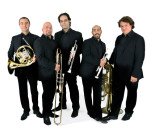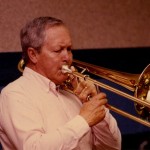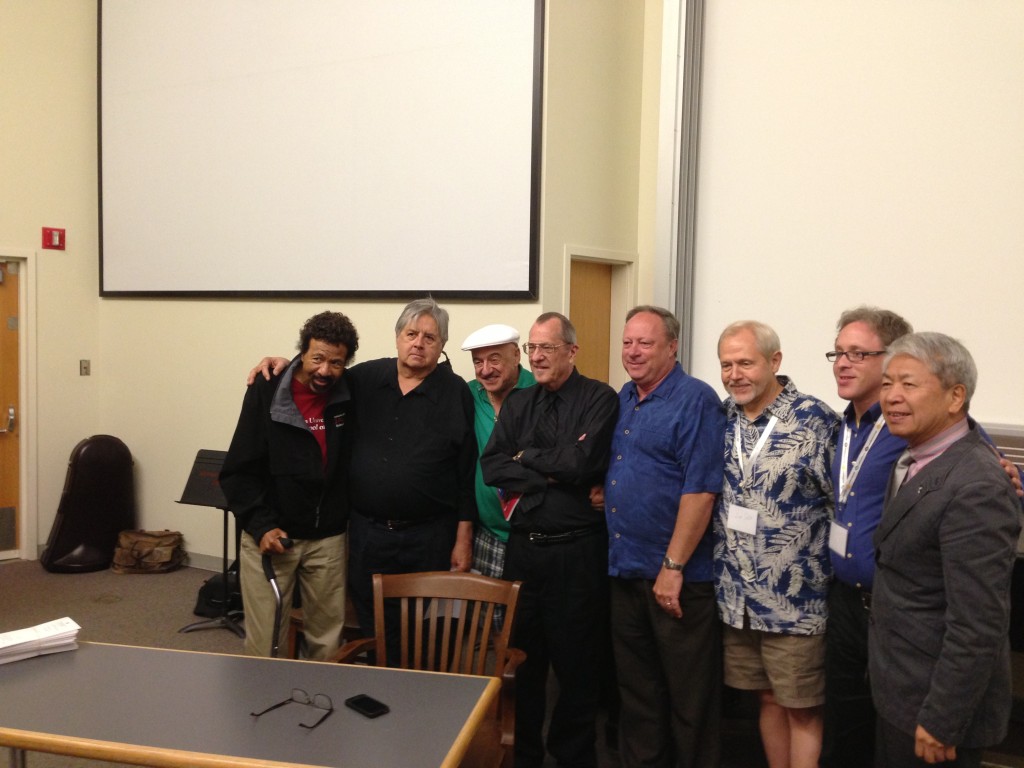Chitate Kagawa performed as the principal tubist of the Sapporo Symphony until his retirement in 2004. In 2010 he was awarded the ITEA Lifetime Achievement Award, and has been a strong advocate for the tuba throughout Japan as host of ITEC Saporo in 1990 and with the Hakkaido Euphonium and Tuba Association. A former student of Harvey Phillips, “The Fourth Valve” tm, Caught up with Mr. Kagawa at the 2014 ITEC at Indiana University, where he had been a student as a young man. It was evident that none of his enthusiasm for music, the tuba, or Mr. Phillips had waned. We are delighted to host Chitate Kagawa for “The Fourth Valve”.
 1. How do you imagine an ideal tuba sound?
1. How do you imagine an ideal tuba sound?
When an excellent singer sings a soft aria with an orchestra, the voice
carries great distances very naturally without having great power, even if it is soft voice. We listen for a very soft tuba sound on the stage, which seems well-balanced with other instruments, but most of the time we can’t hear the
tuba sounds at the seats. This means that this tuba sound doesn’t have enough core,but it is soft. Some say the tuba part should be mixed with the contra
basses, I agree with this concept, but I can’t agree those who say
the tuba should be always be melted in the contra basses. When we listen the
brilliant tuba in the orchestra concert, asa solo performer, or in the
brass quintet, some may feel that the tuba is the most interesting instrument. It is natural, as players, that we listen many types of sound colors produced by a variety of instruments or mouthpieces, and diverse playing techniques which are often quite different from one another. As tubists, we
should listen to many excellent performances, by not only tuba, but
also cello,voice, wood wind etc. This way, we can image an ideal sound on
tuba little by little. We should have good tonal image or ideal and practice every day toward the ideal tuba sound quality and not simply be shouldn’t satisfy present our sounds.
2. What do you look for in an instrument?
When we see or find a fine person, we want to talk with him or her; it is
natural. If the tubist can play very musically with beautiful sound,
then other players will want to play with this player- and not just brass
players. This beautiful approach may attract composers to have an interest in the instrument as well.
Recently, I have heard several tuba players who can play the tuba technically
well without any missing notes at all. It is more difficult, however, to find interesting players. Often,this is because the sound quality is poor and they do not approach the instrument with musicality in mind. Nowadays, I receive a lot of CDs which tuba players have recorded. Every player
plays very well, but I can’t find many of these CDs which I would want to listen to more than once or twice. Perhaps, tuba players should concern themselves with playing more musically, and producing an exceptional tone.. This is more is more important to me than mere technical playing. If we can achieve this, then Tuba will gain more of the spotlight.
3. How are Japanese orchestras different than American orchestras?
Unfortunately, I ave not listened the American orchestras recently,
but each time in the past, I felt the major American orchestras were really great,and played very musically. The brass players’ techniques were excellent
and I could hear their sound from the furthest seat from the stage. But, as a whole, I had not felt a significant or special difference as compared with the
Japanese orchestras.
4. How do you remember Harvey Phillips?
Every one has a hero(es) when they are young. When I was an university
student in Tokyo, I was very impressed by the tuba solo playing on
the records played by Mr.Harvey Phillips. He played: “The Elephant &
the Fly” by H. Kling, “Carioca” by V. Youmans, “Serenade No.12” by V. Persichetti, “Sonata No.1″ by A.Wilder etc.on CC-tuba. There were no Japanese who could play the solo tuba pieces like him. As we know, Mr.Phillips was
the first tuba player who showed us that tuba was also a
solo instrument. His playing technique was tremendous, and I still find myself surprised when I listen to recordings from 1960 to 1970.
Although I joined with the Sapporo Symphony Orchestra in 1969, I
wanted to study with Mr. Phillips. I was very fortunate to be able to study with him for 9 months at Indiana University in 1973 and 1974; I was
selected and sent to the USA to study the tuba by the Japanese
government.
Since I the day that I met him in September of 1973,I maintained close communications with him until he passed away in 2010. Although nine months at Indiana University was not long period, but I had many opportunities to see him work. Mr. Phillips was kind enough to bring me with him to regional Conferences, the Midwest clinic,etc.. I learned a great deal from both him and his wonderful family.
One time, Mr.Phillips told me, Chitate,”throw a stone in the middle
of the pond and see how the waves will expand in all directions”.
This idea was dreamed upon and later became the Hokkaido Euphonium
Tuba Association,founded in Sapporo in 1981 – and this camp has been
successful ever since.
Mr. Phillips introduced me to great tuba and euphonium players who were first
class musicians internationally. This allowed me to invite many tuba/
euphonium players for the annual Hokkaido Euphonium Tuba
Association’s camp. When Mr. Phillips presented a tuba recital in 1979 at
Sapporo, this was the first full tuba recital held by foreign tuba
player in Japan. Since 1984, there has been an unique competition for
the tuba at our camp named The Harvey G.Phillips Tuba Solo
Competition. It is a great honor for young students to receive
Harvey G.Phillips Tuba Solo Competition award.
There were a lot of difficulties to hosting the ITEC Sapporo, 1990, but
this Conference was very successful. Most impoortantly, an entire generation of young Japanese low brass players became familiar with the highest international standards for our instrument. Without
having the strong support of Mr.Phillips in particular, this Conference
could not have been realized. This was the first T.U.B.A.Conference to be held
outside of the United States. It was a very successful Conference
and it became a milestone for Japanese tuba & euphonium players in
our progress on the tuba and euphonium.
I was very honor to receive the Life Time Achievement Award of ITEA
in 2010 at ITEC in Arizona. For this ceremony, Mr.Phillips
commissioned a ceremonial fanfare for 2 euphoniums & 2 tubas named
“Fanfare Kagawa”, written by John Stevens. Later, I received a
photo of Mr.Phillips and Dan Perantoni who were checking up on the rehearsal of
this fanfare from a room of the hospital. This was really special, as
Mr.Phillips was at hospital, and his condition was bad at time
already. I couldn’t find another word to thank him except,Thank you
Mr.Phillips !!!
We enjoyed the great Conference held at Indiana University in 2014.I
believe, Mr.Phillips was also enjoyed this Conference from the grave.
I sincerely appreciate for the many years of kindness he extended to me and my
family.
5. What opportunities do you see for young tubists in Japan in the
future? As soloists? As chamber musicians? In other situations?
In Japan, we have many young tubists who have graduated from our schools of
music and there are many more fine tuba players who has studied in Europe or in
the USA. But, most of them have no good position to play or to teach and
they are staying at big city like in Tokyo. Nevertheless, they know
that the positions with symphony orchestras, militaly bands etc. are
limited, but they are waiting for their turn. I understand their dream
because they are not old, but time is passing very quickly; they
should reflect on the appropriate time to leave the big city in order to find other jobs like teaching at high school or middle school.
It is easier to change jobs when they are young, say before the age of 30. If I am asked for my opinion, I will try to guide younger players with good advice on whether they should continue to study more toward becoming an orchestral player, or should consider becoming a teacher at school..etc.
6. Japanese people seem to love live music from traditional instruments
more than some other cultures. Why do you think that is so ?
I’m not sure Japanese people love the live music from
traditional instruments more than other cultures….
We enjoy a lot of recordings on CD and it is typical for us to listen to
recordings on electronic devices. When I listen to an old record, I can hear the difference of the sound quality. That is when I come to appreciate and prefer the sound by traditional record more than the CD recordings.
7. What is the best tuba playing you have ever heard?
The Hokkaido Euphonium Tuba Association has been inviting guest
artists from abroad for our annual camp since in 1985, and because of this I could listen many fine performances here in Sapporo. I was very happy to hear the duet played by Roger Behrend (euphonium) and Marty
Erickson(tuba) at the mini concert during our annual camp in 1997.
Their performance was the most impressive ensemble, very musically
with beautiful sounds and really well balanced intonations.
Also, I have listened wonderful performances at each ITEC and especially the solo tuba performances. But, the second movement of R.V.Williams tuba concerto
performed by John Fletcher at the World Brass Congress at Indiana
University in 1984 was some of the most impressive playing for me.
Other standouts include the tuba sound quality by Mr.Harvey
Phillips, Robert Tucci & Dan Perantoni. Their sounds have a clear core
with a beautiful sonority. I could listen the great sound, still the
CD, of Mr.Harvey Phillips (ITEA Legacy Series MCD-6069).
The performing of the Fantastique Symphony – H.Berlioz & Tanhauser
overture – R.Wagner as encore piece performed by Chicago Symphony
Orchestra about 30 years ago held in Sapporo was the most impressive
tuba sound I have heard with orchestra, as played by Mr.Arnold Jacobs.
8. What is the best tuba playing you have done so far?
I was not a first class tuba player like many of the recent younger players.
But I have had great memories. The second tuba recital I gave before I left the USA in 1974 (after studying the tuba with Mr. Harvey G.Phillips), was a hoghlight. It was my full tuba solo recital, but Mr.Phillips & I played one duet, Sonata for Bassoon and ‘Cello by W. A. Mozart, which had been transposed for two tubas. It was such an honor to play this duet with Mr. Phillips-yes I would have to say that this was the best playing for me.
c. 2014 David William Brubeck All Rights Reserved. davidbrubeck.com
Interested in more “The Fourth Valve” tm Interviews?
Don Harry
John Stevens
Jim Self
John Van Houten
Demondrae Thurman
Deanna Swoboda
R. Winston Morris
Beth Wiese
Aaron Tindall
Marty Erickson
Beth Mitchell
Chitate Kagawa
Aaron McCalla



